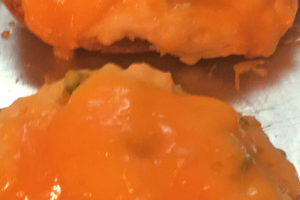Frittatas, I believe, make a perfect luncheon dish—basically easy to make and not too filling. My Sicilian family was particularly fond of this cabbage frittata, which is not as ubiquitous as other vegetable varieties. I’m not certain where it came from, but I did once read that Sicilians who went to Louisiana seemed to be particularly fond of it. My maternal grandmother was born in Baton Rouge, so I always suspected that it was passed down from her mother, who had immigrated from Sicily.
The cabbage frittata is no more difficult to make than any other version, with one exception—it tends to stick to the frying pan. Steps must be taken. I use a cast-iron skillet for frittatas, but whatever pan you use, it must be very well seasoned. If not, rub the pan lightly with any oil, place on a burner, and heat until it is smoking. Once it has cooled, wipe the pan out with a paper towel. Now it is seasoned.
I use about one-half of a medium-sized cabbage. First cut it in half and remove all of the core. Then chop it coarsely. Bring a large pot of salted water to a boil, add the cabbage, and reduce the heat to a medium simmer. Cook only until tender, generally 10-15 minutes. Drain thoroughly and press out as much water as possible. (I use a potato masher for this purpose.) The less water remaining in the cabbage, the less likely it will stick to the pan.
Pour the olive oil into the pan and place it over high heat. When it is hot add the cabbage and stir a few times with a wooden spoon to coat all of the chopped pieces.

Sprinkle on a little salt and pepper and the dry bread crumbs, then stir once. Pour on all of the egg mixture and immediately begin shaking the pan vigorously. When the egg begins to set around the edges, lift the mass with a spatula and tilt the pan back and forth until all the uncooked egg runs under the mixture.

At this point, I begin to run my spatula around the bottom to help prevent sticking. Also, I continue to shake the pan. When most of the uncooked egg has disappeared. Invert the frittata onto a plate. I recommend doing this over the sink to avoid having any uncooked egg or oil drip onto the floor. If any of the mixture has stuck to the pan, don’t panic. Carefully scrape it up and press it into the top of the frittata as elegantly as possible. This eventually will become the bottom, so it won’t show.

The patched-up frittata, done on one side, and slid back into the pan.
Return the pan to the stove. You probably will have to add a little extra oil. When that is hot, carefully slide the frittata into the pan. Again, shake the skillet to prevent sticking. If the frittata slides back and forth in the pan you know it has not stuck. If it has you’ll have to loosen it with your spatula, which will probably disturb the appearance. Lift the edge of the frittata with your spatula to be sure the underside is browned, then invert onto a clean plate.

I find that the frittata tastes best if it is allowed to cool for a few minutes. It can also be served at room temperature.
To print or download the recipe, click here.




